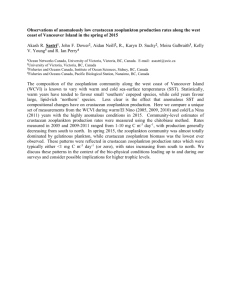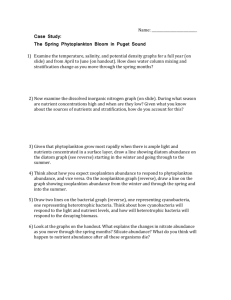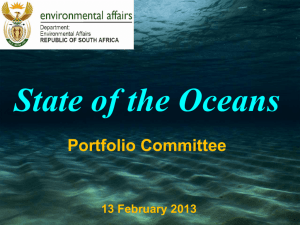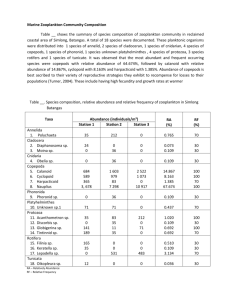Long-term increase in crustacean zooplankton abundance in the
advertisement
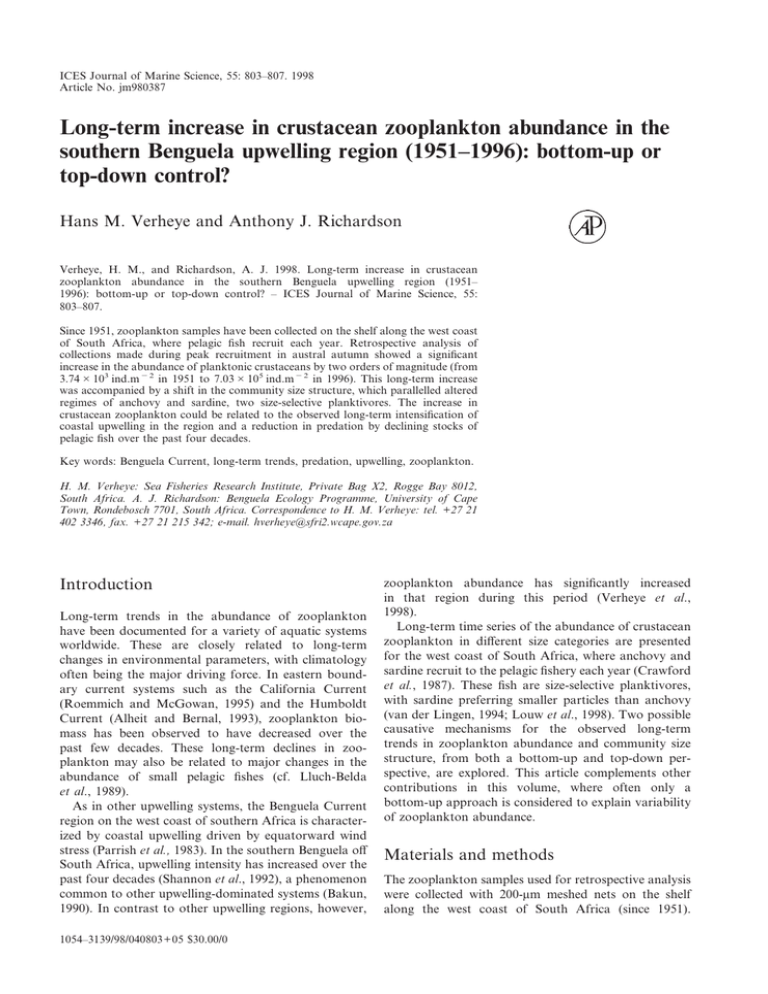
ICES Journal of Marine Science, 55: 803–807. 1998 Article No. jm980387 Long-term increase in crustacean zooplankton abundance in the southern Benguela upwelling region (1951–1996): bottom-up or top-down control? Hans M. Verheye and Anthony J. Richardson Verheye, H. M., and Richardson, A. J. 1998. Long-term increase in crustacean zooplankton abundance in the southern Benguela upwelling region (1951– 1996): bottom-up or top-down control? – ICES Journal of Marine Science, 55: 803–807. Since 1951, zooplankton samples have been collected on the shelf along the west coast of South Africa, where pelagic fish recruit each year. Retrospective analysis of collections made during peak recruitment in austral autumn showed a significant increase in the abundance of planktonic crustaceans by two orders of magnitude (from 3.74103 ind.m 2 in 1951 to 7.03105 ind.m 2 in 1996). This long-term increase was accompanied by a shift in the community size structure, which parallelled altered regimes of anchovy and sardine, two size-selective planktivores. The increase in crustacean zooplankton could be related to the observed long-term intensification of coastal upwelling in the region and a reduction in predation by declining stocks of pelagic fish over the past four decades. Key words: Benguela Current, long-term trends, predation, upwelling, zooplankton. H. M. Verheye: Sea Fisheries Research Institute, Private Bag X2, Rogge Bay 8012, South Africa. A. J. Richardson: Benguela Ecology Programme, University of Cape Town, Rondebosch 7701, South Africa. Correspondence to H. M. Verheye: tel. +27 21 402 3346, fax. +27 21 215 342; e-mail. hverheye@sfri2.wcape.gov.za Introduction Long-term trends in the abundance of zooplankton have been documented for a variety of aquatic systems worldwide. These are closely related to long-term changes in environmental parameters, with climatology often being the major driving force. In eastern boundary current systems such as the California Current (Roemmich and McGowan, 1995) and the Humboldt Current (Alheit and Bernal, 1993), zooplankton biomass has been observed to have decreased over the past few decades. These long-term declines in zooplankton may also be related to major changes in the abundance of small pelagic fishes (cf. Lluch-Belda et al., 1989). As in other upwelling systems, the Benguela Current region on the west coast of southern Africa is characterized by coastal upwelling driven by equatorward wind stress (Parrish et al., 1983). In the southern Benguela off South Africa, upwelling intensity has increased over the past four decades (Shannon et al., 1992), a phenomenon common to other upwelling-dominated systems (Bakun, 1990). In contrast to other upwelling regions, however, 1054–3139/98/040803+05 $30.00/0 zooplankton abundance has significantly increased in that region during this period (Verheye et al., 1998). Long-term time series of the abundance of crustacean zooplankton in different size categories are presented for the west coast of South Africa, where anchovy and sardine recruit to the pelagic fishery each year (Crawford et al., 1987). These fish are size-selective planktivores, with sardine preferring smaller particles than anchovy (van der Lingen, 1994; Louw et al., 1998). Two possible causative mechanisms for the observed long-term trends in zooplankton abundance and community size structure, from both a bottom-up and top-down perspective, are explored. This article complements other contributions in this volume, where often only a bottom-up approach is considered to explain variability of zooplankton abundance. Materials and methods The zooplankton samples used for retrospective analysis were collected with 200-ìm meshed nets on the shelf along the west coast of South Africa (since 1951). H. M. Verheye and A. J. Richardson Sample selection was restricted spatially to the St Helena Bay area and temporally to austral autumn (March– June), the centre and the peak period of recruitment of anchovy and sardine (Crawford et al., 1987). This region is the most productive on the west coast shelf (MitchellInnes and Walker, 1991) because of its position downstream of the Cape Columbine upwelling centre. Crustacean zooplankters, which contributed >97% of total zooplankton (Verheye et al., 1998), were identified and enumerated using standard analysis protocols. Species were classified into five size classes based on their total length: <0.9 mm (cyclopoids), 0.9–1 mm (cladocerans and small calanoids), 1–2 mm (medium calanoids), 2–5 mm (large calanoids) and >5 mm (euphausiids and amphipods). Counts (nos. m 2) were log-transformed (log10[x+1]) to reduce heteroscedasticity and improve normality. Prior testing for parallelism of regression slopes (StatSoft, 1996) of the abundance of the size classes against year showed the slopes to be significantly different (p<0.001; see Verheye et al., 1998). Multiple regressions were therefore computed for each size class, with year, month, distance offshore, surface temperature, and salinity as the independent variables. Non-significant (p>0.05) variables were removed in a backward stepwise process. Because of a 20-year hiatus between 1967 and 1987, separate regressions for the 1951–1967 and 1987–1996 periods were calculated, unless their respective slopes were not significantly different. Initial and final abundances were estimated for each model. A more detailed account of the data sources, sampling strategies, sample and statistical analyses, a list of species, and a critical evaluation of the data are given by Verheye et al. (1998). 6 5 (a) <900 µm TL Slopeyear = 0.052 2 R = 0.50 4 3 2 1 0 1950 1955 1960 1965 1970 1975 1980 1985 1990 1995 6 5 (b) 900–1000 µm TL Slopeyear = 0.054 2 R = 0.59 4 3 2 1 Abundance [log10 (Nos m–2 + 1)] 804 0 1950 1955 1960 1965 1970 1975 1980 1985 1990 1995 6 5 4 (c) 1000–2000 µm TL Slopeyear = n.s. Slopeyear = n.s 3 2 1 0 1950 1955 1960 1965 1970 1975 1980 1985 1990 1995 6 5 (d) 2000–5000 µm TL Slopeyear = 0.038 2 R = 0.39 4 3 2 Results and discussion 1 Time series of the abundance of the crustacean size classes (Fig. 1), together with their respective slopes for the year effect, show that abundances (ind.m 2) of several size categories increased significantly by two orders of magnitude (Fig. 1a, b, d): Size class <0.9 mm 0.9–1 mm 2–5 mm 1951 0.91103 1.06103 0.63103 1996 2.08105 2.90105 3.26104 0 1950 1955 1960 1965 1970 1975 1980 1985 1990 1995 6 5 4 (e) >5000 µm TL Slopeyear = 0.201 2 R = 0.22 Slopeyear = 0.043 2 R = 0.06 3 2 1 0 There was no consistent long-term trend in the abundance of the 1–2 mm size class, which tended to increase during 1951–1967 whilst declining from 1988 onwards, although neither slope was significant (p>0.05; Fig. 1c). In the macrocrustacean size class (>5 mm), there was a difference in slopes between the periods 1951–1967 and 1950 1955 1960 1965 1970 1975 1980 1985 1990 1995 Year Figure 1. Time series of the annual (March–April) mean abundance [log10 (Nos m 2 +1)] of (a) <0.9 mm, (b) 0.9–1 mm, (c) 1–2 mm, (d) 2–5 mm, and (e) >5 mm crustacean zooplankton on the west coast of South Africa, 1951–1996. Error bars are1 s.e. Crustacean zooplankton abundance in the southern Benguela upwelling region 1987–1996 (Fig. 1e). Nevertheless, their abundance increased significantly within each period: Size class 1951 1967 1988 1996 >5 mm 0.05103 0.23103 0.16103 10.75103 S.A. handline catch (1000 t) 10 (a) 8 6 4 2 0 1950 1955 1960 1965 1970 1975 1980 1985 1990 1995 S.A. pelagic catch (100 000 t) 7 6 (b) 5 4 3 2 1 0 1950 1955 1960 1965 1970 1975 1980 1985 1990 1995 Abundance [log10 (Nos m–2+1)] 7 6 5 (c) Crustacean zooplankters Slopeyear = 0.051 2 R = 0.57 4 3 1950 1955 1960 1965 1970 1975 1980 1985 1990 1995 (d) Cape Columbine–St Helena Bay semi-closed circulation system enhanced secondary production Pseudo wind stress anomaly (100 m2 s–2) enhanced primary production increased retention altered circulation increased equatorward advection from Cape Peninsula upwelling centre 3 2 (e) 1 0 –1 –2 –3 1950 1955 1960 1965 1970 1975 1980 1985 1990 1995 Year 805 With the exception of the distance offshore effect, which was positive for the 1–2 mm (1987–1996) and the >5 mm (1951–1967) size classes, year was the only independent variable examined that had a significant effect on the long-term variability in abundance. Figure 2 shows a time series of the abundance of all size classes combined, together with a schematic representation of the bottom-up and top-down control mechanisms proposed. The abundance of planktonic crustaceans has increased significantly over the past 46 years, from 3.74103 in 1951 to 7.03105 ind.m 2 in 1996 (Fig. 2c). Moreover, the community size structure altered markedly through time: the proportion of <0.9 mm crustaceans increased whilst that of >1 mm crustaceans decreased (Fig. 3a), paralleling a regime shift from sardine to anchovy dominance (Fig. 3b). The long-term increase in the overall abundance of crustacean zooplankton could be a consequence of several hydrographic and biological responses (Fig. 2d) to the long-term intensification of coastal upwelling in the Benguela Current region (Fig. 2e; see also Shannon et al., 1992). These include enhanced productivity (Mitchell-Innes and Walker, 1991, but see Figure 4 in Pitcher et al., 1992) within the semi-closed circulation system of the Cape Columbine–St Helena Bay region (Holden, 1985), combined with increased advective input of planktonic biota from the Cape Peninsula upwelling centre further south (Verheye, 1991; Verheye et al., 1991) and their retention within the study area (Verheye et al., 1992). Alternatively, the increasing trend could also be caused by a long-term reduction in predation pressure by planktivorous pelagic fish, since declining pelagic catch data from 1960 onwards (Fig. 2b) suggest a decrease in stock size. This decline, in turn, may result from increased predation by apex predators such as snoek (Thyrsites atun) (Crawford et al., 1995; Fig. 2a) or the Cape fur seal (Arctocephalus pusillus pusillus) (see Figure 2. Schematic of possible causative mechanisms leading to the observed long-term increase in zooplankton in the southern Benguela region (open arrows: top-down control; solid arrows: bottom-up control): (a) time series of annual catch of snoek (Thyrsites atun) made by handline off South Africa, 1961–1995 (updated from Crawford et al., 1995); (– – –) linear regression (R2adj. =0.39; p<0.001; n=33); (b) time series of annual landings of pelagic fish by the South African pelagic industry, 1951–1996 (updated from Schülein et al., 1995); (– – –) post-1960 linear regression (R2adj. =0.47; p<0.001; n=35; outliers 1987 and 1988 excluded); (c) time series of the abundance [log10 (Nos m 2 +1)] of all crustacean zooplankters combined; error bars are1 s.e. (regression equation: y=0.051x+0.996; n=204); (d) diagram of upwelling-related processes within the Cape Columbine–St Helena Bay semiclosed circulation system (cf. Verheye et al., 1992); (e) time series of annual averaged anomalies of equatorward pseudo wind stress representing the southerly, upwelling-favourable component (redrawn from Shannon et al., 1992). 806 H. M. Verheye and A. J. Richardson (a) Crustacean zooplankton size composition 2.0 9.3 1.0 0.4 19.0 41.4 33.6 6.3 55.7 <900 µm 900–1000 1000–2000 2000–5000 >5000 µm 31.4 (b) Pelagic fish catch composition 8.8 20.0 32.0 60.5 19.5 59.2 1951–1967 anchovy sardine other spp. 1988–1996 Figure 3. (a) Percentage composition of crustacean zooplankton size fractions averaged over the periods 1951–1967 and 1988–1996; (b) percentage composition of pelagic fish catches, averaged over the same periods; ‘‘other spp.’’ include predominantly horse mackerel (Trachurus trachurus capensis), round herring (Etrumeus whiteheadi), chub mackerel (Scomber japonicus), and myctophids. Butterworth et al., 1995), the population of which has grown rapidly in recent decades as it recovers from overexploitation. Both bottom-up and top-down mechanisms could be simultaneously responsible for the long-term increase in zooplankton in the southern Benguela, although their relative importance cannot be assessed. That predation could have caused, or contributed to, this long-term trend is in contrast to other studies (e.g. Aebischer et al., 1990) where climate alone has been suggested as the causative mechanism for long-term changes at various trophic levels. Acknowledgements We thank the Sea Fisheries Research Institute of the Department of Environmental Affairs and Tourism, South Africa, for financial support to HMV to attend the Symposium. Logistic support by the South African Museum, Cape Town, and the Benguela Ecology Programme (University of Cape Town) is gratefully acknowledged. We thank two anonymous referees for making valuable comments on an earlier draft of the manuscript. References Aebischer, N. J., Coulson, J. C., and Colebrook, J. M. 1990. Parallel long-term trends across four marine trophic levels and weather. Nature, 347: 753–755. Alheit, J., and Bernal, P. 1993. Effects of physical and biological changes on the biomass yield of the Humboldt Current ecosystem. In Large marine ecosystems – stress, mitigation and sustainability, pp. 53–68. Ed. by K. Sherman, L. M. Alexander, and B. D. Gold. American Association for the Advancement of Science Press, Washington. 376 pp. Crustacean zooplankton abundance in the southern Benguela upwelling region Bakun, A. 1990. Global climate change and intensification of coastal ocean upwelling. Science, 247: 198–201. Butterworth, D. S., Punt, A. E., Oosthuizen, W. H., and Wickens, P. A. 1995. The effects of future consumption by the Cape fur seal on catches and catch rates of the Cape hakes. 3. Modelling the dynamics of the Cape fur seal Arctocephalus pusillus pusillus. South African Journal of Marine Science, 16: 161–183. Crawford, R. J. M., Shannon, L. J., and Nelson, G. 1995. Environmental change, regimes and middle-sized pelagic fish in the South-east Atlantic Ocean. Scientia Marina, 59: 417–426. Crawford, R. J. M., Shannon, L. V., and Pollock, D. E. 1987. The Benguela ecosystem. 4. The major fish and invertebrate resources. In Oceanography and marine biology. An annual review, 25 pp. 353–505. Ed. by M. Barnes. University Press, Aberdeen. 619 pp. Holden, C. J. 1985. Currents in St Helena Bay inferred from radio-tracked difters. In South African ocean colour and upwelling experiment, pp. 97–109. Ed. by L. V. Shannon. Sea Fisheries Research Institute, Cape Town. 270 pp. Lluch-Belda, D., Crawford, R. J. M., Kawasaki, T., MacCall, A. D., Parrish, R. H., Schwartzlose, R. A., and Smith, P. E. 1989. Worldwide fluctuations of sardine and anchovy stocks: the regime problem. South African Journal of Marine Science, 8: 195–205. Louw, G. G., van der Lingen, C. D., and Gibbons, M. J. 1998. Differential feeding by sardine and anchovy recruits in mixed shoals. In Benguela dynamics. Impacts of variability on shelf-sea environments and their living resources. Ed. by S. C. Pillar, C. L. Moloney, A. I. L. Payne, and F. A. Shillington. South African Journal of Marine Science, 19 in press. Mitchell-Innes, B. A., and Walker, D. R. 1991. Short-term variability during an anchor station study in the southern Benguela upwelling system: phytoplankton production and biomass in relation to species changes. Progress in Oceanography, 28: 65–89. Parrish, R. H., Bakun, A., Husby, D. M., and Nelson, C. S. 1983. Comparative climatology of selected environmental processes in relation to eastern boundary current pelagic fish production. In Proceedings of the Expert Consultation to Examine Changes in Abundance and Species Composition of Neritic Fish Resources. Ed. by G. D. Sharp and J. Csirke. F.A.O. Fisheries Report 291: 731–777. Pitcher, G. C., Brown, P. C., and Mitchell-Innes, B. A. 1992. Spatio-temporal variability of phytoplankton in the southern Benguela upwelling system. In Benguela trophic functioning. Ed. by A. I. L. Payne, K. H. Brink, K. H. Mann, and 807 R. Hilborn. South African Journal of Marine Science, 12: 439–456. Roemmich, D., and McGowan, J. 1995. Climatic warming and the decline of zooplankton in the California Current. Science, 267: 1324–1326. Schülein, F. H., Boyd, A. J., and Underhill, L. G. 1995. Oil-to-meal ratios of pelagic fish taken from the northern and the southern Benguela systems: seasonal patterns and temporal trends, 1951–1993. South African Journal of Marine Science, 15: 61–82. Shannon, L. V., Crawford, R. J. M., Pollock, D. E., Hutchings, L., Boyd, A. J., Taunton-Clark, J., Badenhorst, A., MelvilleSmith, R., Augustyn, C. J., Cochrane, K. L., Hampton, I., Nelson, G., Japp, D. W., and Tarr, R. J. Q. 1992. The 1980s – A decade of change in the Benguela ecosystem. In Benguela trophic functioning. Ed. by A. I. L. Payne, K. H. Brink, K. H. Mann, and R. Hilborn. South African Journal of Marine Science, 12: 271–296. Statsoft Inc. 1996. STATISTICA for Windows (Computer program manual). Statsoft Inc., Oklahoma. Van der Lingen, C. D. 1994. Effect of particle size and concentration on the feeding behaviour of adult pilchard Sardinops sagax. Marine Ecology Progress Series, 109: 1–13. Verheye, H. M. 1991. Short-term variability during an anchor station study in the southern Benguela upwelling system: abundance, distribution and estimated production of mesozooplankton with special reference to Calanoides carinatus (Krøyer, 1849). Progress in Oceanography, 28: 91–119. Verheye, H. M., Hutchings, L., and Peterson, W. T. 1991. Life history and population maintenance strategies of Calanoides carinatus (Copepoda: Calanoida) in the southern Benguela ecosystem. South African Journal of Marine Science, 11: 179–191. Verheye, H. M., Hutchings, L., Huggett, J. A., and Painting, S. J. 1992. Mesozooplankton dynamics in the Benguela ecosystem, with emphasis on the herbivorous copepods. In Benguela trophic functioning. Ed. by A. I. L. Payne, K. H. Brink, K. H. Mann, and R. Hilborn. South African Journal of Marine Science, 12: 561–584. Verheye, H. M., Richardson, A. J., Hutchings, L., Marska, G., and Gianakouras, D. 1998. Long-term trends in the abundance and community structure of coastal zooplankton in the southern Benguela system, 1951–present. In Benguela dynamics. Impacts of variability on shelf-sea environments and their living resources. Ed. by S. C. Pillar, C. L. Moloney, A. I. L. Payne, and F. A. Shillington. South African Journal of Marine Science, 19 (in press).

